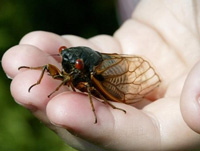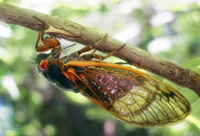print Print...
 (by Seth Borenstein, Associated Press) — Any day now, billions of cicadas with bulging red eyes will crawl out of the earth after 17 years underground and overrun the East Coast. They will arrive in such numbers that people from North Carolina to Connecticut will be outnumbered roughly 600-to-1. Maybe more.
(by Seth Borenstein, Associated Press) — Any day now, billions of cicadas with bulging red eyes will crawl out of the earth after 17 years underground and overrun the East Coast. They will arrive in such numbers that people from North Carolina to Connecticut will be outnumbered roughly 600-to-1. Maybe more.
But ominous as that sounds, …they’re harmless. These insects won’t hurt people or animals. At worst, they might damage a few saplings or young shrubs. Mostly they will blanket certain pockets of the region, though lots of people won’t ever see them. …
Since 1996, this group of 1-inch bugs, in wingless nymph form, has been a few feet underground, sucking on tree roots and biding their time. They will emerge only when the ground temperature reaches precisely 64 degrees. After a few weeks up in the trees, they will die and their offspring will go underground, not to return until 2030. …
And they will make a big racket, too. The noise all the male cicadas make … [is loud]. In 2004, Gene Kritsky, an entomologist at the College of Mount St. Joseph in Cincinnati, measured cicadas at 94 decibels, saying it was so loud “you don’t hear planes flying overhead.”
There are ordinary cicadas that come out every year around the world, but these are different. They’re called magicicadas – as in magic – and are red-eyed. And these magicicadas are seen only in the eastern half of the United States, nowhere else in the world.
There are 15 U.S. broods that emerge every 13 or 17 years, so that nearly every year, some place is overrun. Last year it was a small area, mostly around the Blue Ridge Mountains of Virginia, West Virginia and Tennessee. Next year, two places get hit: Iowa into Illinois and Missouri; and Louisiana and Mississippi. And it’s possible to live in these locations and actually never see them.
This year’s invasion, Brood II, is one of the bigger ones. Several experts say that they really don’t have a handle on how many cicadas are lurking underground but that 30 billion seems like a good estimate. At the Smithsonian Institution, researcher Gary Hevel thinks it may be more like 1 trillion. …
 “There will be some places where it’s wall-to-wall cicadas,” says University of Maryland entomologist Mike Raupp.
“There will be some places where it’s wall-to-wall cicadas,” says University of Maryland entomologist Mike Raupp.
Strength in numbers is the key to cicada survival: There are so many of them that the birds can’t possibly eat them all, and those that are left over are free to multiply, Raupp says.
But why only every 13 or 17 years? Some scientists think they come out in these odd cycles so that predators can’t match the timing and be waiting for them in huge numbers. Another theory is that the unusual cycles ensure that different broods don’t compete with each other much.
And there’s the mystery of just how these bugs know it’s been 17 years and time to come out, not 15 or 16 years. …
Past cicada invasions have seen as many as 1.5 million bugs per acre. Of course, most places along the East Coast won’t be so swamped, and some places, especially in cities, may see zero, says Chris Simon of the University of Connecticut. For example, Staten Island gets this brood of cicadas, but the rest of New York City and Long Island don’t, she says. The cicadas also live beneath the metro areas of Philadelphia, Baltimore and Washington.
Scientists and ordinary people with a bug fetish travel to see them. Thomas Jefferson once wrote about an invasion of this very brood at Monticello, his home in Virginia.
While they stay underground, the bugs aren’t asleep. They go through different growth stages and molt four times before ever getting to the surface. They are some of the world’s longest-lived insects. They drink up a low-protein tree fluid called xylum, which isn’t essential to the tree. Then they go aboveground, where they molt, leaving behind a crusty brown shell, and grow a half-inch bigger.
The timing of when they first come out depends purely on ground temperature. That means early May for southern areas and late May or even June for northern areas.
The males come out first…. They come out first as nymphs, which are essentially wingless and silent juveniles, climb on to tree branches and molt one last time, becoming adult winged cicadas. They perch on tree branches and sing, individually or in a chorus. Then when a female comes close, the males change their song, they do a dance and mate, he explained.
The males keep mating…and eventually the female lays 600 or so eggs on the tip of a branch. The offspring then dive-bomb out of the trees, bounce off the ground and eventually burrow into the earth, he says.
“It’s a treacherous, precarious life,” Raupp says. “But somehow they make it work.”
Reprinted here for educational purposes only. May not be reproduced on other websites without permission from the Associated Press. Visit the website at ap.org.
Questions
1. a) When will the Brood II cicadas emerge?
b) How often do the Brood II cicadas show up?
2. Where will these cicadas emerge? Be specific.
3. How many Brood II cicadas are expected to emerge in total?
4. What is the difference between the Brood II and other cicadas?
5. Why do scientists think these special cicadas appear so many years apart?
Daily “Answers” emails are provided for Daily News Articles, Tuesday’s World Events and Friday’s News Quiz.



